Eleven Secret Wars tie-ins this week, but the good news is that seven of them are conclusions; there’s a growing light at the end of Jonathan Hickman’s three-year-old tunnel. Let’s look at all of them one at a time:
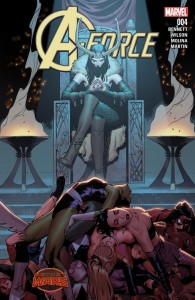 Secret Wars: A-Force #4 (of 5) — Writers: Marguerite Bennett and G. Willow Wilson; Pencils: Jorge Molina; Inks: Craig Yeung and Walden Wong; Colors: Laura Martin
Secret Wars: A-Force #4 (of 5) — Writers: Marguerite Bennett and G. Willow Wilson; Pencils: Jorge Molina; Inks: Craig Yeung and Walden Wong; Colors: Laura Martin
This tryout/preview for one of Marvel’s new relaunch titles has been decent enough, with sharp character interaction among a diverse, interesting cast. Its momentum gets spoiled here through no fault of its own: the climactic scene is a two-page splash, at the book’s centerfold, that’s meant to be read across both pages. However, Marvel’s inserted a four-page foldout ad in that centerfold too, blocking the effect, confusing the reader, and ruining the story. It’s a surprisingly-stupid screwup that, fortunately, the reader can fix: open the ad to where it’s stapled to the comic, gently work it off the staples, and look at the page the way its creators intended (you can reinsert the ad, off the staples, and still have my permission to call it NM…). Be prepared to do the same for Siege #3 and Amazing Spider-Man: Renew Your Vows #5, which also have ad-ruined splashes.
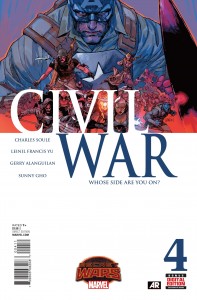 Secret Wars: Civil War #4 (of 5) — Writer: Charles Soule; Pencils: Leinil Francis Yu; Inks: Gerry Alanguilan; Colors: Sunny Gho
Secret Wars: Civil War #4 (of 5) — Writer: Charles Soule; Pencils: Leinil Francis Yu; Inks: Gerry Alanguilan; Colors: Sunny Gho
I have to admit it’s kind of warmly nostalgic to see Yu drawing Skrulls and Luke Cage and the other Avengers, even as we get to the end of issue four at exactly the cliffhanger we’ve all seem coming since the first issue, and now still have to wait another month for the conclusion.
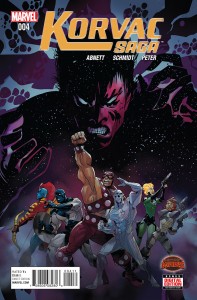 Secret Wars: Korvac Saga #4 (of 4) — Writer: Dan Abnett; Art: Otto Schmidt; Colors: Cris Peter
Secret Wars: Korvac Saga #4 (of 4) — Writer: Dan Abnett; Art: Otto Schmidt; Colors: Cris Peter
This got better as it went along, because Abnett was saving the big cosmic stuff for the very end. He’s been hobbled by the tie-in rules — his protagonist can’t actually affect the main story (i.e., challenge Doom and win) because anything that important has to appear in the actual Secret Wars comic — but still manages to leave his characters in an interesting place.
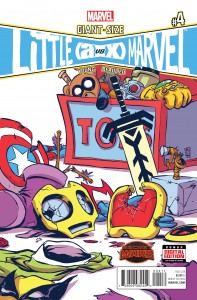 Secret Wars: Giant-Size Little Marvel #4 (of 4) — Writer/Artist: Skottie Young; Colors: Jean-Francois Beaulieu
Secret Wars: Giant-Size Little Marvel #4 (of 4) — Writer/Artist: Skottie Young; Colors: Jean-Francois Beaulieu
There’s a little too much all-but-the-kitchen-sink in this final issue, but you have to admire Young’s willingness to draw the little-kid versions of the Avengers and the X-Men and the Guardians of the Galaxy and the Inhumans and a final surprise group at the end, all while throwing in two double-page battle splashes (his pint-size Dr. Strange, inexplicably still with Fu Manchu mustache and prematurely-white temples, is almost worth the $3.99 by itself).
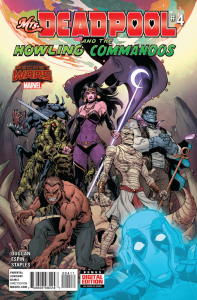 Secret Wars: Mrs. Deadpool and the Howling Commandoes #4 (of 4) — Writer: Gerry Duggan; Art: Salva Espin; Colors: Val Staples
Secret Wars: Mrs. Deadpool and the Howling Commandoes #4 (of 4) — Writer: Gerry Duggan; Art: Salva Espin; Colors: Val Staples
Like Korvac Saga, this has another of those foregone it-can’t-go-well conclusions, but both story and art are just off-kilter enough to feel like a Deadpool book — not to mention Wade as ghostly narrator, breaking the fourth wall and reminding us that he’ll be back in a new series in just a month.
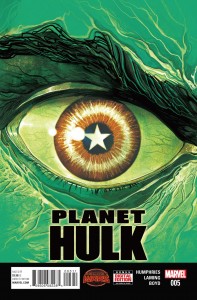 Secret Wars: Planet Hulk #5 (of 5) — Writer: Sam Humphries; Art: Marc Laming; Colors: Jordan Boyd
Secret Wars: Planet Hulk #5 (of 5) — Writer: Sam Humphries; Art: Marc Laming; Colors: Jordan Boyd
This has the advantage of not trying for the big cosmic world-shaking story, but opting for a smaller scale — if you can accept a Steve Rogers dressed like Conan the Barbarian, riding a big red intelligent T-rex through a Hulkified landscape, as “smaller scale.” The plot’s got one or two satisfying twists, but spending five issues of this comic on a quest, only to reveal it as meaningless, asks a lot of readers; this would have worked just as well, and felt less padded, at three issues instead.
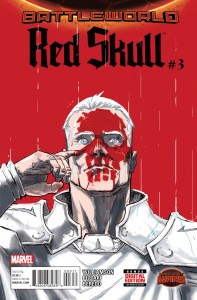 Secret Wars: Red Skull #3 (of 3) — Writer: Joshua Williamson; Art: Luca Pizzari; Colors: Rainier Beredo
Secret Wars: Red Skull #3 (of 3) — Writer: Joshua Williamson; Art: Luca Pizzari; Colors: Rainier Beredo
See? At three issues, this book’s just long enough: few dull spots, and this final issue’s all-out battle between Magneto, the Skull, zombies and Shield-wall Sentinels zips along nicely, with an ending as precise and final as a sniper’s bullet.
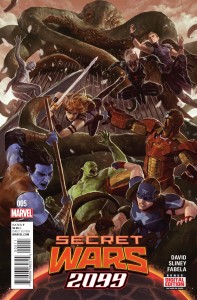 Secret Wars: 2099 #5 (of 5) — Writer: Peter David; Art: Will Sliney; Colors: Antonio Fabela
Secret Wars: 2099 #5 (of 5) — Writer: Peter David; Art: Will Sliney; Colors: Antonio Fabela
This one’s pretty good, too, especially if you have fond memories of any of the original 2099 titles; it barely mentions Secret Wars at all, and can be read as a stand-alone Marvel-future story (maybe for the best, too, since otherwise you’d have to ask how, on the Doom-created Battleworld, a Cthulhu-like demon like the main bad guy here could exist…).
 Secret Wars: Siege #3 (of 4) — Writer: Kieron Gillen; Art: Felipe Andrade; Colors: Rachelle Rosenberg
Secret Wars: Siege #3 (of 4) — Writer: Kieron Gillen; Art: Felipe Andrade; Colors: Rachelle Rosenberg
This is Gillen writing about battles on the Shield Wall, led by Abigail Brand and Kang against mutates like a Nick Fury/unstoppable robot Fury mashup, and including Ms. America Chavez, Kate Bishop/Hawkeye and Leah from the Loki stories; it’s also got double-page sprawling-battle splashes from three guest artists: Julian Tedesco, Juan Jose Ryp and Michael Kaluta (although the Ryp one is marred by having one of those stupid Marvel house ads in the middle of it), and concludes with the appearance of yet another major player, one that indicates this will probably wrap right into the main Secret Wars title with its conclusion. So, you know, you should probably buy it….
 Secret Wars: 1602: Witch Hunter Angela #3 (of 4) — Writers: Marguerite Bennett and Kieron Gillen; Art/Colors: Stephanie Hans and Frazier Irving
Secret Wars: 1602: Witch Hunter Angela #3 (of 4) — Writers: Marguerite Bennett and Kieron Gillen; Art/Colors: Stephanie Hans and Frazier Irving
The main story here is by Bennett and Hans, while Gillen and Irving contribute a five-page side story involving the Elizabethan-era versions of Cloak and Dagger as actors in Shakespeare’s company playing, first, Othello and Desdemona and then Romeo and Juliet (Gillen’s having quite the week, between this, Siege and his two wonderful independent books with Jamie McKelvie, The Wicked and the Divine and Phonograph… but we’ll get to those later). Bennett and Han, meanwhile, do a good job evoking the long-ago setting, and bringing modern Marvel characters like Rogue and the Enchantress into it, while still making it all feel familiar to readers of the regular Angela book.
 Secret Wars: Amazing Spider-Man: Renew Your Vows #5 (of 5) — Writer: Dan Slott; Art: Adam Kubert and Scott Hanna; Colors: Justin Ponsor
Secret Wars: Amazing Spider-Man: Renew Your Vows #5 (of 5) — Writer: Dan Slott; Art: Adam Kubert and Scott Hanna; Colors: Justin Ponsor
This is another book that reaches its conclusion without having much connection to the overall Secret Wars story — but that’s OK, since its tale of an alternate-timeline Peter who gave up the webs years ago, even in the face of tyranny, to protect his wife Mary Jane and their newborn daughter, has an action-packed and satisfying conclusion: all three of the Parker family, including their now-preteen, spider-powered daughter Annie, against the big bad guy. If you’re still irritated over the Mephisto-fueled retcon of the Parker marriage, this is a good use of the SW model to revisit it, with old pros Slott and Kubert delivering a story that feels like it’s “real,” and an effective glimpse of what might have been.
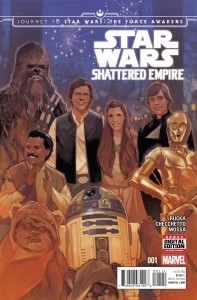 Star Wars: Shattered Empire #1 — Writer: Greg Rucka; Art: Marco Checchetto; Colors: Andres Mossa
Star Wars: Shattered Empire #1 — Writer: Greg Rucka; Art: Marco Checchetto; Colors: Andres Mossa
Quake: S.H.I.E.L.D. 50th Anniversary #1 (of 1) — Writers: Matthew Rosenberg and Patrick Kindlon; Art: Daniel Warren Johnson; Colors: Jason Keith
A few other Marvel books: the Star Wars is significant because it occurs immediately after Return of the Jedi, and is the first official/Disney book about the events that eventually will lead to the new movie this Christmas. Tapping Rucka as writer continues Marvel’s pattern of assigning A-listers to the Star Wars books, although his 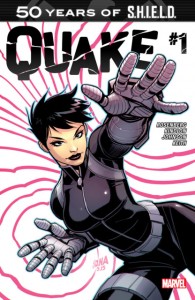 reputation is more for police procedurals and crime noir, so it’ll be interesting to see how he does on cosmic space opera; Checchetto has the looks of the main characters down pat, and gets off a decent double-page-splash space-battle scene, so this is off to a good start. The Quake one-shot (part of a series rebounding off of S.H.I.E.L.D.’s 50th anniversary) has that agent/Inhuman/TV show character getting called up on a mission with the main Avengers team (one from a couple of years ago, with the Red Hulk, and Steve Rogers still as Captain America), and, other than making Tony Stark more of a jerk than he probably should be, is fine; it isn’t startlingly good, but does OK in offering a first solo tale for this ever-more-visible character.
reputation is more for police procedurals and crime noir, so it’ll be interesting to see how he does on cosmic space opera; Checchetto has the looks of the main characters down pat, and gets off a decent double-page-splash space-battle scene, so this is off to a good start. The Quake one-shot (part of a series rebounding off of S.H.I.E.L.D.’s 50th anniversary) has that agent/Inhuman/TV show character getting called up on a mission with the main Avengers team (one from a couple of years ago, with the Red Hulk, and Steve Rogers still as Captain America), and, other than making Tony Stark more of a jerk than he probably should be, is fine; it isn’t startlingly good, but does OK in offering a first solo tale for this ever-more-visible character.
 Harley Quinn Road Trip Special #1 (of 1) — Writers: Amanda Connor and Jimmy Palmiotti; Art: Bret Blevins with Moritat, Flaviano Armentaro, Pasquale Qualano, Jed Dougherty and Mike Manley; Colors: Paul Mounts
Harley Quinn Road Trip Special #1 (of 1) — Writers: Amanda Connor and Jimmy Palmiotti; Art: Bret Blevins with Moritat, Flaviano Armentaro, Pasquale Qualano, Jed Dougherty and Mike Manley; Colors: Paul Mounts
Batman #44 — Writers: Scott Snyder and Brian Azzarello; Art: Jock; Colors: Lee Loughridge
All-Star Section Eight #4 (of 6) — Writer: Garth Ennis; Art: John McCrea; Colors: John Kalisz
Three DC books. The Harley one-shot has her, Poison Ivy and Catwoman going on a cross-country road trip, which is 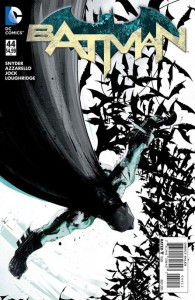 probably all most of you need to know to buy it; Connor and Palmiotti, the regular Harley book writers, make sure it’s got some actual character development, and isn’t all about the titillation (although the women seem to wear bikinis a lot anyway…). The guest artists show up to draw a psychedelic sequence after our heroines accidentally drink peyote, and later have an encounter with Jimmy Olson and Bizarro, from that off-center Superman clone’s title (and, if you’re wondering how Olson is doing that while he’s supposed to be playing a main part in the Superman comics… well, you’re probably thinking too much to be reading a Harley Quinn comic). The Batman is a change-of-pace flashback story, with Bruce Wayne still Batman and set right after the Zero Year
probably all most of you need to know to buy it; Connor and Palmiotti, the regular Harley book writers, make sure it’s got some actual character development, and isn’t all about the titillation (although the women seem to wear bikinis a lot anyway…). The guest artists show up to draw a psychedelic sequence after our heroines accidentally drink peyote, and later have an encounter with Jimmy Olson and Bizarro, from that off-center Superman clone’s title (and, if you’re wondering how Olson is doing that while he’s supposed to be playing a main part in the Superman comics… well, you’re probably thinking too much to be reading a Harley Quinn comic). The Batman is a change-of-pace flashback story, with Bruce Wayne still Batman and set right after the Zero Year 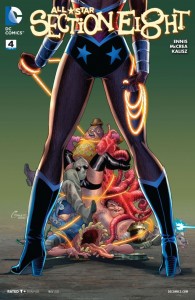 events, with Brian Azzarello co-writing; it’s about the investigation into the mysterious death of a teenager, and while it has a few links to current continuity (like a blink-and-you’ll-miss-it appearance by Mr. Bloom), it’s at heart a traditional done-in-one detective story with a couple of smart themes. If you haven’t been thrilled with this book’s Gordon-as-Batman present day, then this story from an earlier time is one you’ll appreciate (and the shadow-saturated art, by Jock, complements it nicely). All-Star Section Eight, meanwhile, continues its cheerful deconstruction of all things decent and superheroic, as Wonder Woman shows up, gets accidentally hit on the head, and, her brains scrambled, decides to hang out with the Noonan’s Bar crew. It’s equal parts slapstick comedy and wince-inducing transgression, a territory that creators Ennis and McCrea know how to mine expertly.
events, with Brian Azzarello co-writing; it’s about the investigation into the mysterious death of a teenager, and while it has a few links to current continuity (like a blink-and-you’ll-miss-it appearance by Mr. Bloom), it’s at heart a traditional done-in-one detective story with a couple of smart themes. If you haven’t been thrilled with this book’s Gordon-as-Batman present day, then this story from an earlier time is one you’ll appreciate (and the shadow-saturated art, by Jock, complements it nicely). All-Star Section Eight, meanwhile, continues its cheerful deconstruction of all things decent and superheroic, as Wonder Woman shows up, gets accidentally hit on the head, and, her brains scrambled, decides to hang out with the Noonan’s Bar crew. It’s equal parts slapstick comedy and wince-inducing transgression, a territory that creators Ennis and McCrea know how to mine expertly.
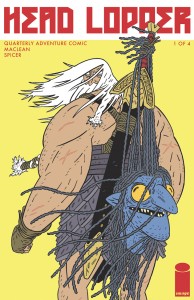 Head Lopper #1 — Writer/Artist: Andrew Maclean; Colors: Mike Spicer
Head Lopper #1 — Writer/Artist: Andrew Maclean; Colors: Mike Spicer
Tyson Hesse’s Diesel #1 (of 4) — Writer/Artist: Tyson Hesse; Colors: Mariel Cartwright
Broken Moon #1 (of 4) — Writer: Steve Niles; Art/Colors: Nat Jones
Faster Than Light #1 — Writer/Artist: Brian Haberlin; Colors: Geirrod VanDyke
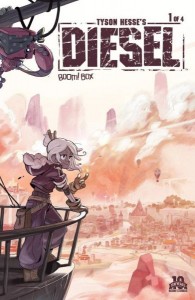 A quartet of independent-comic first issues: Head Lopper is a sword-and-sorcery book on steroids, Conan crossed with Heavy Metal by way of Samurai Jack, about a huge guy with a sword who goes around, yes, chopping off heads, including that of an old crone whom, still animated, gets carried around by him and acts as a sarcastic Greek chorus for his battles against various monsters and other antagonists. For $5.99, this first issue offers over eighty pages of art, brightly colored and kinetic as hell: it’s one of those books that you never knew you needed but, once read, you won’t be able to live without. Diesel is another quirky offering, a mashup of steampunk, manga and classic animation about an eighteen-year-old heroine, her family
A quartet of independent-comic first issues: Head Lopper is a sword-and-sorcery book on steroids, Conan crossed with Heavy Metal by way of Samurai Jack, about a huge guy with a sword who goes around, yes, chopping off heads, including that of an old crone whom, still animated, gets carried around by him and acts as a sarcastic Greek chorus for his battles against various monsters and other antagonists. For $5.99, this first issue offers over eighty pages of art, brightly colored and kinetic as hell: it’s one of those books that you never knew you needed but, once read, you won’t be able to live without. Diesel is another quirky offering, a mashup of steampunk, manga and classic animation about an eighteen-year-old heroine, her family 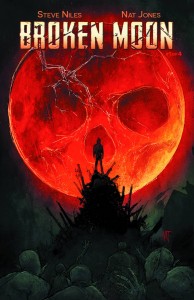 airship, and a mysterious engine that drops from the sky; Hesse is one of those names that may not be familiar to most readers (he drew Boom’s previous Amazing World of Gumball), but he’s obviously been honing his skills for a long time, and this is clearly a labor of love for him, and well worth checking out. Broken World is by the always-dependable horror writer Steve Niles; its premise is that various countries have colonized the moon, but end up conducting a nuclear war on it, fracturing the satellite and devastating the Earth; with humanity all but wiped out, once-thought-mythical monsters like vampires and werewolves come out of the shadows to take over. Artist Jones has a very Ben Templesmith-like style that suits this material well, and at four issues it’s just the right
airship, and a mysterious engine that drops from the sky; Hesse is one of those names that may not be familiar to most readers (he drew Boom’s previous Amazing World of Gumball), but he’s obviously been honing his skills for a long time, and this is clearly a labor of love for him, and well worth checking out. Broken World is by the always-dependable horror writer Steve Niles; its premise is that various countries have colonized the moon, but end up conducting a nuclear war on it, fracturing the satellite and devastating the Earth; with humanity all but wiped out, once-thought-mythical monsters like vampires and werewolves come out of the shadows to take over. Artist Jones has a very Ben Templesmith-like style that suits this material well, and at four issues it’s just the right 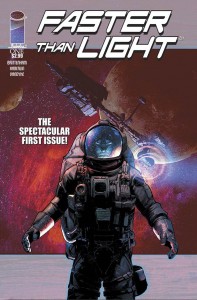 size to be entertaining and not overstay its welcome. Faster Than Light, as its title implies, is another Image sf book; an Earth scientist has discovered a way to utilize FTL travel, while at the same time our military has discovered that we’re in the crosshairs of an aggressive, predatory alien race; thus, a ship and crew are cobbled together quickly to explore our near-galactic neighborhood, and try to find either allies or technology to give us an edge in the coming war. That’s a lot to cover, and this first issue mostly introduces the concept and crew, sets up the inevitable clash on the ship between the scientists and the soldiers, and gets them onto a nearby planet; it’s a little talky, but promises quite a bit more action in its next issue.
size to be entertaining and not overstay its welcome. Faster Than Light, as its title implies, is another Image sf book; an Earth scientist has discovered a way to utilize FTL travel, while at the same time our military has discovered that we’re in the crosshairs of an aggressive, predatory alien race; thus, a ship and crew are cobbled together quickly to explore our near-galactic neighborhood, and try to find either allies or technology to give us an edge in the coming war. That’s a lot to cover, and this first issue mostly introduces the concept and crew, sets up the inevitable clash on the ship between the scientists and the soldiers, and gets them onto a nearby planet; it’s a little talky, but promises quite a bit more action in its next issue.
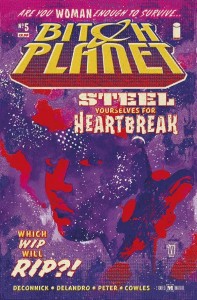 Bitch Planet #5 — Writer: Kelly Sue DeConnick; Art: Valentine de Landro; Colors: Cris Peter
Bitch Planet #5 — Writer: Kelly Sue DeConnick; Art: Valentine de Landro; Colors: Cris Peter
The Wicked and the Divine #14 — Writer: Kieron Gillen; Art: Jamie McKelvie; Colors: Matthew Wilson
Phonogram: The Immaterial Girl #2 (of 6) — Writer: Kieron Gillen; Art: Jamie McKelvie; Colors: Matthew Wilson
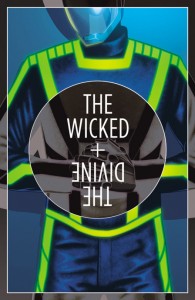 Outcast #12 — Writer: Robert Kirkman; Art: Paul Azeceta; Colors: Elizabeth Breitweiser
Outcast #12 — Writer: Robert Kirkman; Art: Paul Azeceta; Colors: Elizabeth Breitweiser
Injection #5 — Writer: Warren Ellis; Art: Declan Shalvey; Colors: Jordie Bellaire
Rebels #6 — Writer: Brian Wood; Art: Andrea Mutti; Colors: Jordie Bellaire
Deadly Class #16 — Writer: Rick Remender; Art: Wes 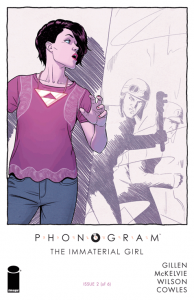 Craig; Colors: Jordan Boyd
Craig; Colors: Jordan Boyd
All the other indy books — Bitch Planet is Kelly Sue Deconnick and Valentine de Landro’s justly-acclaimed feminist/sf/women in prison/B-movie combo comic: smart, poignant, politically aware and action-packed. The Wicked and the Divine and Phonogram: The Immaterial Girl are both by Kieron Gillen and Jamie McKelvie, the team responsible for Young Avengers, among others. Wicked and Divine is an interesting experiment: it’s made up entirely of panels from previous issues, remixed and remastered, to summarize the story so far from the perspective of Wodan, the assistant to main 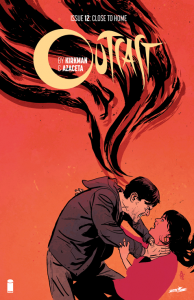 puppeteer/villain Ananke. It’s a good move; this comic has a large cast and a lot of moving parts, so offering a kind of clip show/deep breath makes a lot of sense. The original Phonogram was the Gillen/McKelvie team’s first collaboration, so this third volume lets them revisit some familiar characters. It’s very pop-music-centric (its main conceit is “phonomancy,” the idea that magic comes from music, and that a great pop song generates its own energy, which a skilled magician can command), with tributes to ’80s and ’90s videos, sly album and single criticism, and endnotes that, taken across all three volumes, form an encyclopedia of modern British rock; add in McKelvie’s art,
puppeteer/villain Ananke. It’s a good move; this comic has a large cast and a lot of moving parts, so offering a kind of clip show/deep breath makes a lot of sense. The original Phonogram was the Gillen/McKelvie team’s first collaboration, so this third volume lets them revisit some familiar characters. It’s very pop-music-centric (its main conceit is “phonomancy,” the idea that magic comes from music, and that a great pop song generates its own energy, which a skilled magician can command), with tributes to ’80s and ’90s videos, sly album and single criticism, and endnotes that, taken across all three volumes, form an encyclopedia of modern British rock; add in McKelvie’s art,  simultaneously slick and compellingly human, and it’s a great show. Outcast, the Kirkman Exorcist riff that’s going to be a series from Cinemax next year, reaches its 12th issue (and, thus, the end of its second arc), with some revelations/hints about what’s actually going on and one of those dramatic, effective “Here’s how it’s going to be” statements from the main character that we’re used to seeing from Rick Grimes over in Walking Dead; Azaceta continues to get better at his use of shadows, and of a kind of grounded creeping horror, with each issue. Injection finally sees Ellis explaining what’s actually going on (character on the first page: “We’ve
simultaneously slick and compellingly human, and it’s a great show. Outcast, the Kirkman Exorcist riff that’s going to be a series from Cinemax next year, reaches its 12th issue (and, thus, the end of its second arc), with some revelations/hints about what’s actually going on and one of those dramatic, effective “Here’s how it’s going to be” statements from the main character that we’re used to seeing from Rick Grimes over in Walking Dead; Azaceta continues to get better at his use of shadows, and of a kind of grounded creeping horror, with each issue. Injection finally sees Ellis explaining what’s actually going on (character on the first page: “We’ve 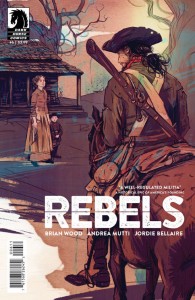 injected into the internet an almost-conscious machine learning system that can mess with the state of the world.” All righty, then…), and after that and some similar infodumpy passages ratchets up the action and the horror (if breaking the spell on someone who’s possessed requires turning their clothing inside-out, but they’re naked, what do you do? Well, first get a sharp knife…); it’s impressive that Shalvey’s art fits the tone so perfectly here, and yet looks nothing like his previous collaboration with Ellis on Moon Knight. Rebels ends its first arc, about a Vermont soldier in the Revolutionary War (one of Ethan Allen’s Green Mountain Boys), with a coda about what happens when he finally returns home after the
injected into the internet an almost-conscious machine learning system that can mess with the state of the world.” All righty, then…), and after that and some similar infodumpy passages ratchets up the action and the horror (if breaking the spell on someone who’s possessed requires turning their clothing inside-out, but they’re naked, what do you do? Well, first get a sharp knife…); it’s impressive that Shalvey’s art fits the tone so perfectly here, and yet looks nothing like his previous collaboration with Ellis on Moon Knight. Rebels ends its first arc, about a Vermont soldier in the Revolutionary War (one of Ethan Allen’s Green Mountain Boys), with a coda about what happens when he finally returns home after the 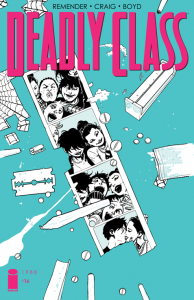 hostilities are concluded, and discovers the real price of his service to his new country; this first arc should yield a good-selling trade collection. Finally, Deadly Class, Rick Remender’s tale of a high school just as screwed up and full of impossible relationships, hormonal confusion and soul-crushing choices as yours — except that it’s also a training ground for young assassins, so, you know, even more so — reaches its sixteenth issue. That’s impressive, especially considering that it’s just getting started, with Craig’s energetic layout and clear line combining with Remender’s careful plotting and characterization to bring everything so far to a boil, with a perfect last-page, apocalyptic cliffhanger.
hostilities are concluded, and discovers the real price of his service to his new country; this first arc should yield a good-selling trade collection. Finally, Deadly Class, Rick Remender’s tale of a high school just as screwed up and full of impossible relationships, hormonal confusion and soul-crushing choices as yours — except that it’s also a training ground for young assassins, so, you know, even more so — reaches its sixteenth issue. That’s impressive, especially considering that it’s just getting started, with Craig’s energetic layout and clear line combining with Remender’s careful plotting and characterization to bring everything so far to a boil, with a perfect last-page, apocalyptic cliffhanger.



